Can you make bread without yeast or sourdough starter? Try fermented fruit water
Whilst chatting with fellow female breadbakers from Bread Chat, Michelle, from Planet Leicester Bakers mentioned she was going to make raisin water and inspired by a South African bread from her childhood, Mosbolletjies. This fired up everyone’s imagination, so we all set out to have a go.
Could we make bread without yeast?
Would raisin water work for everyone? Did we all have the ingredients? And would we follow the recipe exactly as that’s just the sort of thing we do, experiment (and not follow instructions). But there really was nothing to loose!
Over a period of 4 days, the raisins would ferment. After that time, hopefully, it would be lively enough to use in a bread recipe rather than using yeast or sourdough.
Through trial and error, we found (in general) that untreated dried fruit worked best – probably no surprise there. There were some issues, some people’s mix didn’t work at all, on others there appeared to be some mould. So if it looks weird, it probably is. Discard it and start again.
Sonya then suggested making a paste with the fermented water and flour (equal quantities). This was treated left to ferment half a day, then used in the same way a sourdough starter would be used. Results below!
First of all the recipe. Links to Michelle’s original instructions are included later.
Inspired by the recipe, we tried making different versions – some sweet others with different flours. Some were successful, others weren’t. We all agreed it was a great challenge and one that inspired many people to have a try. I hope you will too. It is always good to try something new!
Raisin Water Bread
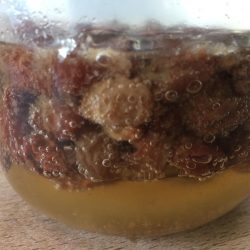
Bread recipe using raisin water
Equipment
- A jar with a lid that will hold 400 ml; large bowl, baking tray or baking tin
Ingredients
- 57 grams raisins sultanas work well. Try to use untreated fruit
- 280 millilitres water 170 for initial fermentation
- 400 grams white bread flour
- 6 grams salt
Instructions
- In your jar, add 57 grams of raisins and 170 ml water. Make sure the water is 5 cm above the raisins. Replace the lid, but do not seal. Leave for 4 days giving it a shake each day. For the first few days, very little will happen. By the 4th day, you should see plenty of bubbles and some of the raisins will float to the top.

- You will now use the water in the ferment in your dough. Set the raisins aside for another use. Top the water up to 280 ml.

- Place your flour and salt in a bowl and add the 280 ml water. Mix well and knead until smooth. This will take about 10 minutes by hand or 5 minutes in a stand mixer.
- Place in a container with a lid and leave out in the kitchen for 6-8 hours. The dough will be springy and have risen. You should see some bubbles
- Shape the dough into a ball by pulling the dough and drawing in the sides. Turn the dough ball over and roll. At this stage you can place it in a 2lb baking tin or on a well-floured couche or linen tea towel
- Preheat your oven to 200°C half an hour before needed
- Prove for 6-8 hours before baking. It should be well risen and if prodded the dimple will fill very slowly
Notes
Look what we made!
Soon, we found we had success on our hands and rather than simply make the mosbolletjes, we started experiments with different fruits and flours. Of course, not everything went well, and we made quite a few bricks along the way. Michelle’s videos inspired others on Instagram. There was no stopping us now.
Steph’s sultanas seemed to be turbo charged. Her unsorbated date water proved to work really well.
I tried sultanas and made these sweet cinnamon buns. Although my second attempt with figs was not a success. There was fermentation, but I baked a brick.
Joan Ransley is a food photographer. She also tried the raisin water and produced such a beautiful Instagram post
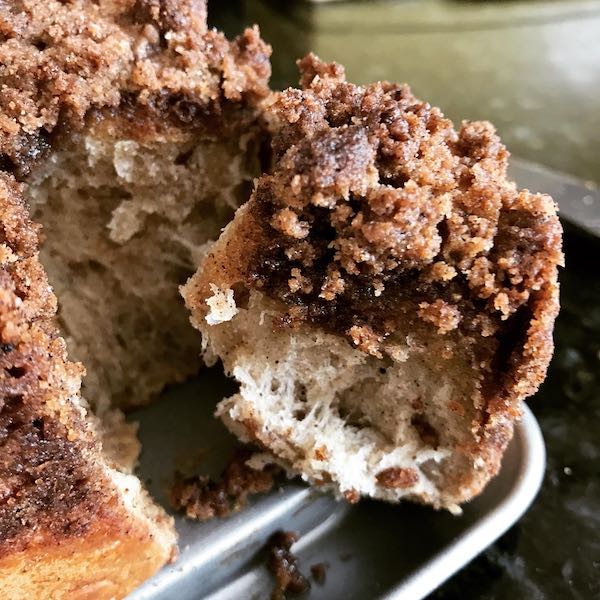
Sonya usually bakes bread in her woodfired oven, her domestic oven got a turn for the raisin bread.
Taking it a step further, transforming the fermented water into a paste and then using that to ferment.
Michelle’s Videos and Instructions for Raisin Water
The full set of instructional videos are available on Planet Leicester Bakers Instagram feed.
Who are we?
We are a lively group of female breadbakers who love to experiment. We’re reviving Bread Chat check out the next edition.
Who we are:
Sonya Hundal. Rural wood-fired baker and writer. Owner of Greenfield Bakers. Follow Sonya on Twitter and Instagram
Ameena Nur: Owner of Jeju’s Bakehouse, based in Scotland. Baking the world a better place one loaf at a time. Follow Ameena on Twitter and Instagram
Steph Clubb, Bread, pastry and pasta tutor, home economist and food stylist. Specialised area, gluten free new product development. Follow Steph on Twitter and Instagram
Danielle Ellis, creator of Severn Bites Breadmaking Classes, French trained, World Bread Awards Judge, Rofco fanatic. Follow Danielle on Twitter and Instagram
Ruth Macintyre: owner of Ruth’s Little Kitchen . Follow Ruth on Twitter and Instagram
Dilly Boase – Bread baker specialising in sourdough, with a love of experimental baking. Follow Dilly on Twitter and Instagram
Michelle Stratford Founder Planet Leicester Bakers. Fourth generation home bread baker. Baking, teaching and building community bridges with good bread. Follow Michelle on Twitter and Instagram
Find out more
The Fresh Loaf delve further into the science of raisin water.
Discover bread making techniques in my Bake Better Bread series

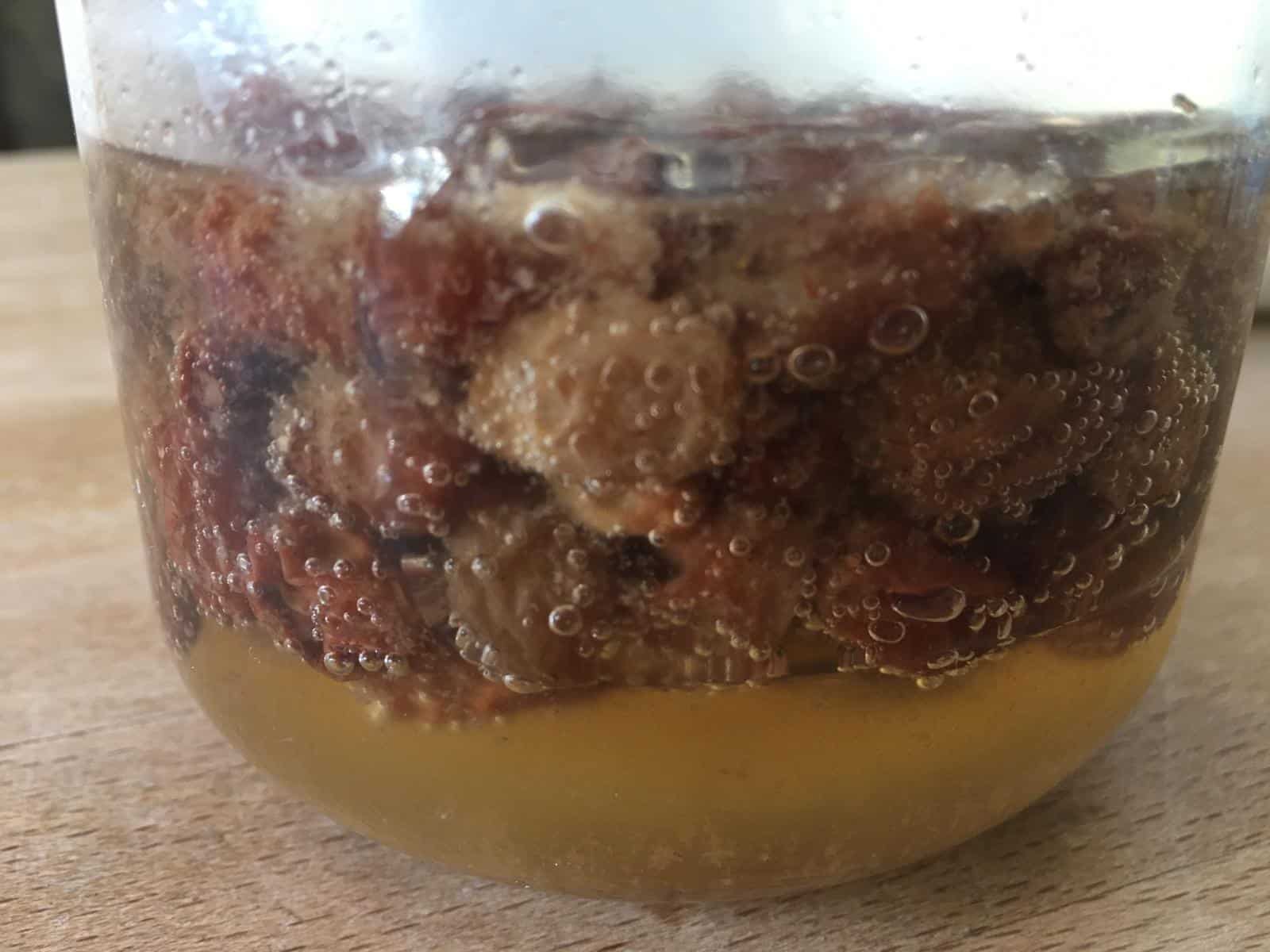
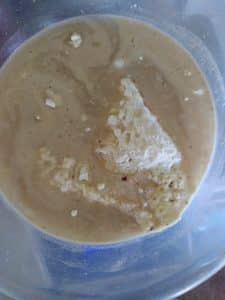
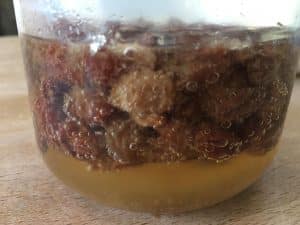
My 1947 South African Department of Agriculture cookbook says dedicate a calabash to fermenting raisins, and do not wash it out. The fermentation process is a lot faster and one gives it a wipe after use.
Would love to hear how you get on! You might like to join online Bread Chat on 2nd September.
This is so interesting! I’m gonna try. Thank you for sharing.
What I cannot understand is putting the salt in when you mix the flour with the raisin water. Isn’t that impeding the development at that stage? Also I am going to try doubling the raisin water and flour and put 1/2 in fridge for my new wild yeast starter!